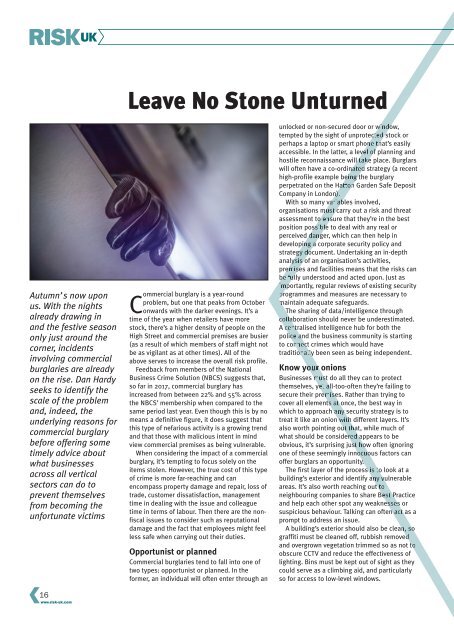RiskUKOctober2017
You also want an ePaper? Increase the reach of your titles
YUMPU automatically turns print PDFs into web optimized ePapers that Google loves.
Leave No Stone Unturned<br />
Autumn’s now upon<br />
us. With the nights<br />
already drawing in<br />
and the festive season<br />
only just around the<br />
corner, incidents<br />
involving commercial<br />
burglaries are already<br />
on the rise. Dan Hardy<br />
seeks to identify the<br />
scale of the problem<br />
and, indeed, the<br />
underlying reasons for<br />
commercial burglary<br />
before offering some<br />
timely advice about<br />
what businesses<br />
across all vertical<br />
sectors can do to<br />
prevent themselves<br />
from becoming the<br />
unfortunate victims<br />
Commercial burglary is a year-round<br />
problem, but one that peaks from October<br />
onwards with the darker evenings. It’s a<br />
time of the year when retailers have more<br />
stock, there’s a higher density of people on the<br />
High Street and commercial premises are busier<br />
(as a result of which members of staff might not<br />
be as vigilant as at other times). All of the<br />
above serves to increase the overall risk profile.<br />
Feedback from members of the National<br />
Business Crime Solution (NBCS) suggests that,<br />
so far in 2017, commercial burglary has<br />
increased from between 22% and 55% across<br />
the NBCS’ membership when compared to the<br />
same period last year. Even though this is by no<br />
means a definitive figure, it does suggest that<br />
this type of nefarious activity is a growing trend<br />
and that those with malicious intent in mind<br />
view commercial premises as being vulnerable.<br />
When considering the impact of a commercial<br />
burglary, it’s tempting to focus solely on the<br />
items stolen. However, the true cost of this type<br />
of crime is more far-reaching and can<br />
encompass property damage and repair, loss of<br />
trade, customer dissatisfaction, management<br />
time in dealing with the issue and colleague<br />
time in terms of labour. Then there are the nonfiscal<br />
issues to consider such as reputational<br />
damage and the fact that employees might feel<br />
less safe when carrying out their duties.<br />
Opportunist or planned<br />
Commercial burglaries tend to fall into one of<br />
two types: opportunist or planned. In the<br />
former, an individual will often enter through an<br />
unlocked or non-secured door or window,<br />
tempted by the sight of unprotected stock or<br />
perhaps a laptop or smart phone that’s easily<br />
accessible. In the latter, a level of planning and<br />
hostile reconnaissance will take place. Burglars<br />
will often have a co-ordinated strategy (a recent<br />
high-profile example being the burglary<br />
perpetrated on the Hatton Garden Safe Deposit<br />
Company in London).<br />
With so many variables involved,<br />
organisations must carry out a risk and threat<br />
assessment to ensure that they’re in the best<br />
position possible to deal with any real or<br />
perceived danger, which can then help in<br />
developing a corporate security policy and<br />
strategy document. Undertaking an in-depth<br />
analysis of an organisation’s activities,<br />
premises and facilities means that the risks can<br />
be fully understood and acted upon. Just as<br />
importantly, regular reviews of existing security<br />
programmes and measures are necessary to<br />
maintain adequate safeguards.<br />
The sharing of data/intelligence through<br />
collaboration should never be underestimated.<br />
A centralised intelligence hub for both the<br />
police and the business community is starting<br />
to connect crimes which would have<br />
traditionally been seen as being independent.<br />
Know your onions<br />
Businesses must do all they can to protect<br />
themselves, yet all-too-often they’re failing to<br />
secure their premises. Rather than trying to<br />
cover all elements at once, the best way in<br />
which to approach any security strategy is to<br />
treat it like an onion with different layers. It’s<br />
also worth pointing out that, while much of<br />
what should be considered appears to be<br />
obvious, it’s surprising just how often ignoring<br />
one of these seemingly innocuous factors can<br />
offer burglars an opportunity.<br />
The first layer of the process is to look at a<br />
building’s exterior and identify any vulnerable<br />
areas. It’s also worth reaching out to<br />
neighbouring companies to share Best Practice<br />
and help each other spot any weaknesses or<br />
suspicious behaviour. Talking can often act as a<br />
prompt to address an issue.<br />
A building’s exterior should also be clean, so<br />
graffiti must be cleaned off, rubbish removed<br />
and overgrown vegetation trimmed so as not to<br />
obscure CCTV and reduce the effectiveness of<br />
lighting. Bins must be kept out of sight as they<br />
could serve as a climbing aid, and particularly<br />
so for access to low-level windows.<br />
16<br />
www.risk-uk.com

















